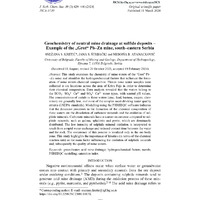Geochemistry of neutral mine drainage at sulfide deposits ‒ example of the „Grot“ Pb-Zn mine, South-Eastern Serbia
Објеката
- Тип
- Рад у часопису
- Верзија рада
- објављена верзија
- Језик
- енглески
- Креатор
- Snežana Kretić, Jana Štrbački, Nebojša Atanacković
- Извор
- Journal of the Serbian Chemical Society
- Издавач
- National Library of Serbia
- Датум издавања
- 2024
- Сажетак
- U ovom radu proučavan je hemijski sastav voda iz rudnika i izdvojeni su hidro-geohemijski faktori koji utiču na njegovo formiranje. Sakupljeno je 11 uzoraka vode sa 6 lokacija na području Krive Feje, kako bi se utvrdio njihov hemijski sastav. Analizom podataka utvrđeno je da su vode sa ovog područja visokog kvaliteta, HCO3--SO42--Ca2+ i SO42--Ca2+ tipa, sa neutralnom pH vrednošću. Koncentracije metala u ovim vodama (cinka, olova, barijuma, bakra i hroma) generalno su niske i većina uzoraka voda ispunjava kriterijume vode za piće (US EPA standarde). Modeliranje pomoću PHREEQC softvera ukazuje na to da su dominantni procesi u formiranju hemijskog sastava ovih voda rastvaranje karbonatnih minerala i oksidacija sulfidnih minerala. Karbonatni minerali imaju manju zastupljenost u odnosu na sulfidne minerale (poput galenita, sfalerita i pirita), koji su dominantni na području istraživanja. Slab intenzitet oksidacije sulfidnih minerala posledica je brze zamene vode i smanjenog kontakta vode sa stenom. Proces oksidacije sulfidnih minerala je lokalnog karaktera i vezuje se samo za zonu ležišta. Ova studija ukazuje na značaj kinetike (tj. brzine hemijske reakcije), kao jednog od glavnih faktora u procesu oksidacije sulfidnih minerala.
- This study examines the chemistry of mine waters of the “Grot” Pb– –Zn mine and identifies the hydrogeochemical factors that influence the formation of mine waters chemical composition. Eleven mine water samples were collected at six locations across the area of Kriva Feja in order to determine their chemical composition. Data analysis revealed that the waters belong to the HCO3 -‒SO4 2-‒Ca2+ and SO4 2-‒Ca2+ water types, with neutral pH values. The concentrations of metals in these waters (zinc, lead, barium, copper, chromium) are generally low, and most of the samples meet drinking water quality criteria (USEPA standards). Modelling using the PHREEQC software indicates that the dominant processes in the formation of the chemical composition of these waters are the dissolution of carbonate minerals and the oxidation of sulphide minerals. Carbonate minerals have a scarcer occurrence compared to sulphide minerals, such as galena, sphalerite and pyrite, which are dominantly distributed. The low intensity of sulphide mineral oxidation is interpreted to result from a rapid water exchange and reduced contact time between the water and the rock. The occurrence of this process is localized only in the ore body zone. This study highlights the importance of kinetics (in terms of the chemical reaction rate) as the main factor influencing the oxidation of sulphide minerals and, subsequently the quality of mine waters.
- том
- 89
- Број
- 3
- почетак странице
- 429
- крај странице
- 440
- doi
- 10.2298/jsc230811013k
- issn
- 0352-5139
- Просторно покривање
- Srbija
- Subject
- podzemne vode, kisele rudničke vode, hidrogeohemijski faktori, metali, PHREEQC modeliranje, indeks saturacije
- groundwater, acid mine drainage, hydrogeochemical factors, metals, PHREEQC modelling, saturation index
- Шира категорија рада
- M20
- Ужа категорија рада
- М23
- Права
- Отворени приступ
- Лиценца
- Creative Commons – CC0 Public Domain
- Формат
- Медија
 Kretic et al. 2024.pdf
Kretic et al. 2024.pdf
Snežana Kretić, Jana Štrbački, Nebojša Atanacković. "Geochemistry of neutral mine drainage at sulfide deposits ‒ example of the „Grot“ Pb-Zn mine, South-Eastern Serbia" in Journal of the Serbian Chemical Society, National Library of Serbia (2024). https://doi.org/10.2298/jsc230811013k М23
This item was submitted on 8. јануар 2025. by [anonymous user] using the form “Рад у часопису” on the site “Радови”: https://dr.rgf.bg.ac.rs/s/repo
Click here to view the collected data.